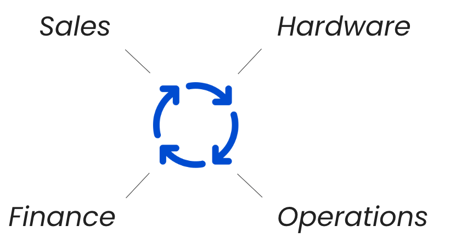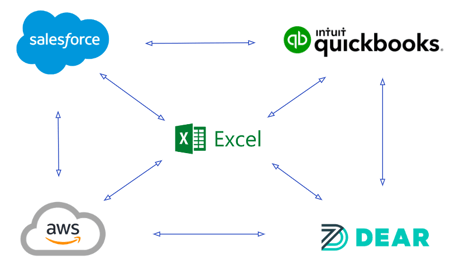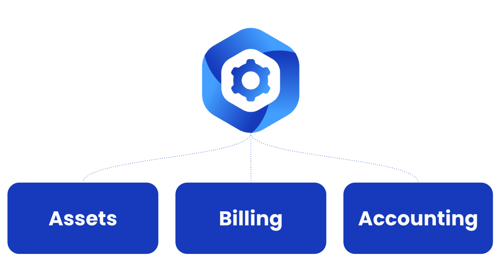The challenges of implementing a hardware-as-a-service (HaaS) model
by Zachary Kimball on June 30, 2023
As hardware-as-a-service (HaaS) becomes more prevalent, we’ve had the opportunity to speak with hundreds of business leaders who’ve invested in many different HaaS business models.
There are two related sets of challenges and opportunities we see repeatedly:
Operational challenges and cross-functional complexity
- Hardware companies are surprised by the operational complexity involved in executing a HaaS business model. Ongoing cross-functional coordination is key to success, and is considerably more complex than for traditional hardware or software businesses.
- For example, companies offering a “hybrid” HaaS model introduce sold assets, which must still be tracked as non-inventory, and subscription billing, which must be managed on a recurring basis.
Bespoke systems and custom data solutions
- Companies offering HaaS try to address operational complexities with bespoke systems, but struggle to ensure the basic building blocks of their business are functioning smoothly.
- For example, companies offering a full “subscription” model often pay consultants or developers to concoct bespoke solutions to connect data between systems.
Operating HaaS is no small feat: it’s high cost, high effort, and demands a great deal of deliberate forethought. That’s why a unified solution is needed to manage hardware financial operations.
Operational challenges and cross-functional complexity
Ongoing cross-functional coordination is key to success in a HaaS model, where it is more complex than traditional hardware or software businesses. Each team is part of a process where information is consistently needed from other teams, and each action has downstream impacts, on a recurring basis.

|
"We're offering hardware-as-a-service, but it's such a clunky process. What we have is so far from optimal. The technology is rudimentary and we struggle with integrations. It's just much more complicated than SaaS." —VP of Engineering |
Sales, marketing, and pricing
Things get complicated for sales in a HaaS model because the business potentially has up to eight different components to a HaaS solution. Some components may be sold outright, some may be charged on a recurring basis, and some might have billing related to another product (e.g., a software subscription starts when an asset is deployed). Just a straightforward quote for such solutions can be difficult, and there are many complicated steps that follow.
Major customer relationship management (CRM) and contract-price-quote (CPQ) solutions are not designed to capture the level of nuance that HaaS pricing demands. Recurring fees are one thing; but a typical HaaS contract might say that setup fees are due at signing, the hardware is billed upon shipment, warranty kicks in when the asset is delivered, and the software subscription starts when the hardware is deployed. This is impossible to automate, even with a modern enterprise resource planning (ERP) system.
Upstream, sales teams may need to know which assets are available for sale, and when those assets can be deployed. Sales also needs to communicate downstream to a hardware or inventory team about upcoming shipments, and to the service team about a subscription renewal. All of this information is also relevant for finance stakeholders, who must manage billing and accounting—one-time and recurring—for the solution.
Hardware, manufacturing, and inventory
In a traditional capex model, hardware is sold and the hardware team doesn’t have to think about it again. But in a HaaS model, the manufacturer has an ongoing relationship with the customer that requires understanding the asset over time.
That means the hardware team not only needs to hear from sales where assets are going and when they need to ship. This also means that information must be communicated downstream to an operations team to turn on the hardware and activate its corresponding software, and shared with a service team on an ongoing basis for monitoring and support.
As a result, hardware also has mission-critical information for the finance team to initiate appropriate billing and accounting. Without a unified communication option available to share the full extent of these details, information is usually assembled in spreadsheets and passed through emails or a messaging service.
Operations, installation, and service
Operations is broadly responsible for both installation and service, though the team divisions vary by company. Ultimately operations is interested in tracking finished-goods inventory upstream; along with which equipment was shipped where; what products have been delivered; where assets have been relocated; which equipment is currently deployed; and what the asset’s condition is.
This set of information is not captured natively in CRM, ERP, or internet-of-things (IoT) data, so it usually ends up spread across several spreadsheets across the organization.1 In the best case, companies may be using a cloud spreadsheet service to sync the information across teams. More often, Excel files are emailed across departments. In either case, that still doesn’t capture the whole story: for example, a software subscription may have begun after an asset was shipped and installed. Those records often live in other disconnected systems such as a cloud computing platform.
Depending on the structure of a HaaS contract, some or all of this information is likely to be relevant for the finance and accounting teams as well. Because asset activity is often tied up with lease rules, title transfer, warranty requirements, and inter-state tax jurisdictions, it’s critical to have a clear and connected paper trail.
Finance, accounting, and analytics
Finance is ultimately the choke point for many of these cross-functional problems, because they may need to gather dozens of data points to manage a single customer over time.2 Effectively every action taken by another team on the HaaS journey impacts finance, which makes the challenges experienced by the finance team particularly acute.
In a typical HaaS model, finance often needs to know every action at every stage in the contract and asset lifecycle. A small sample of “milestones” that might occur for a basic contract:
- Down payment due at signing
- Cost of warranty also due at signing
- Shipping fee charged on shipment
- Hardware tax calculated on shipment
- Asset revenue starts being recognized on shipment
- Installation charge due on delivery
- Service plan billed on delivery
- Warranty takes effect on delivery
- Installation revenue recognized on deployment
- Balance of hardware fee (plus tax) billed on deployment
- Recurring software fee begins on asset deployment
- Asset BOM, labor costs, shipping, installation, and taxes loaded for depreciation after deployment
- Service revenue recognized over the life of the contract
- Deferred warranty revenue recognized over the life of the warranty
- Recurring software fees are recognized over time
- Billing and recognition must be paused when an asset is non-functional
When the data isn’t available with unified reporting, some finance teams are forced to reach out to the warehouse, call the shipping department, text the installation team driver, and more in order to know how to handle the contract correctly. Depending on the structure of a company’s finance team, this may impact contracting, accounts receivable, FP&A, accounting, and audit.3
A HaaS finance team is running 3 different teams—hardware, leasing, and subscription. But no CEO is going to triple the size of a finance team to deal with these three different types of business! So finance is forced to build out complex processes and suboptimal systems to make sense of it all.
Bespoke systems and custom data solutions
We’ve heard hundreds of stories about the frustrations of operating a HaaS business. We’ve also seen a lot of custom approaches—some of them remarkably complex—to handle these challenges.

|
"ERPs are inflexible for manufacturers and it's impossible to do subscriptions well. We tried for a year! It was such a pain, we went back to Excel. Now we meet monthly to go over spreadsheets and find errors every time." |
There are three types of bespoke systems that HaaS companies utilize when attempting to address these operational challenges. Most companies move from one stage to the next as they scale.
Early stage: start with spreadsheets
- Summary. Most teams start capturing data in a team-specific spreadsheet—whether it’s asset inventory, shipment dates, metrics details, or billing information. Teams often share spreadsheets, email CSVs, export data from a CRM, and upload it to other systems.
- Challenges. Spreadsheets tend to lead to a lot of informational drift, and team-specific spreadsheets are even worse. This is the least scalable model and organizations start seeing missing data or data corruption well before they hit scale.
- Assessment. This is the most common approach we see when businesses get started with HaaS. Companies just have to be careful not to let this system grow or it can be difficult to unwind. We often see a threshold of impracticality after 4 dozen assets, 3 dozen customers, or 2 dozen locations—whichever comes first.
Growth model: connect a cloud database
- Summary. Companies set up a cloud database and a system to ping the cloud database when changes or updates happen. This type of system may utilize tools like Zapier to move information around based on manual or automatic triggers from databases and spreadsheets.
- Challenges. These systems usually start with a small internal promise that building a database will be easy. After being built, the system continues to expand, taking up additional developer effort. Such systems also have to be maintained internally for an indefinite period, taking up valuable time that could instead be spent on core productive business activities. License fees and software costs can balloon rapidly and, even when certain steps are automated, other steps remain manual indefinitely.
- Assessment. This is the “start spending internal resources” implementation. Costs add up quickly, but are usually not transparent. At one company we estimated over $500k in annual FTE costs dedicated to supporting their internal HaaS system.4
Most complex: build data pipelines to the ERP
- Summary. Get data from a CRM, stream it through a complex iPaaS solution, push data from assets to an IoT database, pull related data from a cloud warehouse, then connect the data to an ERP. This usually involves hiring consultants, contractors, integrators, and several full-time staff to set up and manage each of these systems.
- Challenges. Such systems are expensive, time intensive, difficult to unwind, and never fully resolve the complexity of HaaS—because CRMs and ERPs alone were not built to manage hardware subscriptions. Such systems may solve 80% of problems with a more transparent cost than building something bespoke from scratch in house. But an in-house effort is then required to solve the remaining 20% of business problems.
- Assessment. This is the “million dollar” implementation. But it’s a long list of companies that sign up for data tools to connect CRMs to ERPs and can’t make them successful.5
Others look to software products that do not actually enable HaaS.6 Unified reporting is not available without adopting a tool dedicated to hardware financial operations, or falling back on extensive in-house customization.
Hardfin: the unified solution for hardware financial operations
Ultimately, implementing an effective hardware-as-a-service program boils down to two core challenges: coordinating teams and integrating systems. Taking charge of hardware financial operations is… hard. That’s why we built Hardfin.

|
"I wish we had Hardfin when I got started. Systems were painful and the data was a nightmare. Meaningful errors build up in ways that are hard to detect or understand. Strategic leaders in hardware need a system like Hardfin early on in order to prevent problems down the road." |
Hardfin is the financial operations platform for modern hardware businesses. We support HaaS companies running a variety (or combination!) of models:
- Hardware sold + subscription software
- Hardware lease + service plan
- “All-in fixed price” bundle with hardware + software + service
- Usage-based pricing on a pay-per-use basis
- Leveraging hardware to capture data and then selling the data
- and more…
The Hardfin platform was designed from the ground up to solve hardware financial operations and enable businesses to manage the complexity of hardware subscriptions. So whatever the challenge—tracking assets, upselling services, managing recurring billing, automating lease accounting, or integrating usage-based models—we’re here to help.
| As HaaS business models evolve, technology is evolving to support it. That’s where Hardfin comes in: manage, operate, and report on your hardware, regardless of the complexity of your business model. | ||
1. We’ve seen as few as 3 spreadsheets and as many as 36 at companies we’ve spoken to about this problem!
2. HaaS companies charging based on usage face a particularly complex problem, where finance teams may be responsible for managing hundreds or even thousands of data points in order to manage billing and accounting.
3. In at least one case, a HaaS unit was on loan to the marketing team for a photo shoot—that single asset held up the annual audit by a month because fixed assets did not reconcile, forcing teams across the company to search for and locate the missing unit.
4. Organizations as small as a few hundred people quickly allocate part-time work from engineers, designers, product managers, data analysts, finance analysts, accountants, and business operations to manage the complexity of HaaS. In an organization with 500 employees, we’ve seen “part time” people costs alone exceed $500,000/year for internal HaaS management.
5. One such company realized they didn’t have internal resources to configure it correctly, so the tool sat unused for a year and then they canceled the contract.
6. Another company was pitched a $4M contract by Oracle to install a leasing module for banks that would not actually enable HaaS.
- HaaS (74)
- hardware as a service (74)
- haas100 (40)
- business model (9)
- billing (7)
- contract (4)
- equipment (4)
- RaaS (3)
- accounting (3)
- asset management (3)
- financing (3)
- operations (3)
- MSP (2)
- legal (2)
- managed service provider (2)
- revenue (2)
- robotics (2)
- robots-as-a-service (2)
- DaaS (1)
- MaaS (1)
- actions (1)
- assets (1)
- business model examples (1)
- device-as-a-service (1)
- eaas (1)
- equipment-as-a-service (1)
- finance (1)
- hardware financing (1)
- machine-as-a-service (1)
- pricing (1)
- product update (1)
- sales tax (1)
- solution definition (1)
- tax (1)
- December 2025 (1)
- November 2025 (2)
- October 2025 (2)
- September 2025 (2)
- August 2025 (3)
- July 2025 (3)
- June 2025 (2)
- May 2025 (2)
- April 2025 (2)
- March 2025 (4)
- February 2025 (4)
- January 2025 (3)
- December 2024 (3)
- November 2024 (2)
- October 2024 (2)
- September 2024 (3)
- August 2024 (2)
- July 2024 (2)
- June 2024 (2)
- May 2024 (1)
- April 2024 (2)
- February 2024 (3)
- January 2024 (3)
- December 2023 (3)
- November 2023 (3)
- October 2023 (3)
- September 2023 (1)
- August 2023 (2)
- July 2023 (2)
- June 2023 (1)
- May 2023 (1)
- April 2023 (2)
- March 2023 (1)
- February 2023 (1)


